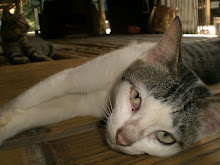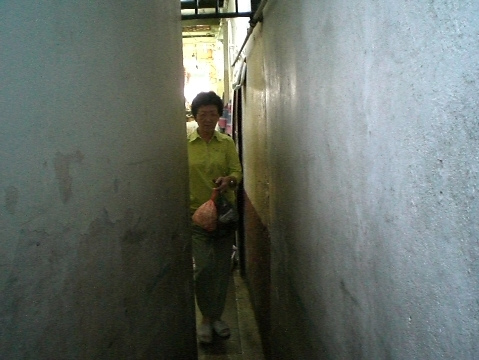But it doesn’t have to be this way. A cruise to nowhere? Why, we have it right here in good ol’ Sarawak, Kuching to be precise. Now, I’m not saying it’s as romantic as riding the gondola on a moonlit Venice night or the wet-your-pants roller coaster of white water rafting, and certainly it lacks the creature comfort of being in an ocean liner. But what the heck, it’s good clean, wobbly fun. Welcome to the tambang of Sungai Sarawak.

The flimsy looking sampan, called a tambang locally, is actually a large canoe of varying length from 15 to 20 feet long, and about 4 to 5 feet wide. Originally catering to ferrying the kampung folks living across the Sarawak River to the Main Bazaar and back, nowadays, the cigarette dangling from the frail weather-beaten Malay boatman’s lips wouldn't drop even if hordes of ogling tourists descent upon his vessel, as long as they don’t rock it for fun.

This endearing icon of “life in the slow lane” can actually be a therapeutic break for the high-strung stress-pressed corporate ladder climbers, if only for a brief duration of half-hour return trip and costing literally a cup of coffee without milk.
These ferries usually berth at the many landing points along the Kuching Waterfront. Thus if you are going to the Astana or its vicinity, choose the landing point right opposite to it, or if you’re visiting the kampung further down stream, go further down the Waterfront where there is another berthing place. There are many of these tambangs plying the river day and night.
By the way, don’t bother asking for the schedule or timetable. As long as the boat is reasonably filled up, he sets sail. But “reasonably” filled up can also mean just one passenger which could be the boatman’s kampung neighbour who’s in labour, and she probably doesn't have to pay a single cent. Thus, I suspect for a fistful of red-colour Malaysian banknotes, he may be willing break his routine and take you for a ride, I mean, to unscheduled stops, (farther downstream, upstream) if its not “rush hour”. But do check this out yourself.
As you hop on to the platform of the boat, you may unwittingly step on a cluster of coins of various denomination lying on it. Don’t be a busy body by scooping them up and smilingly ask who’d drop some coins. These are the fare that all passengers drop as they step off the boat on arriving at their destination. The fare is usually 30 sen, but some generous hearts give more. If you don't have change and have to drop a ringgit note, you may help yourself to some change, but hey, what’s a few cents donation to the poor guy and making our economy stronger?
As the “roof” is only 4 feet high, going inside this boat is like lowering yourself to enter a tunnel. Besides, the vessel is configured to accommodate the small frame of the local denizens, many a tall guy and Caucasians passengers have been seen to actually crawl in! When you are comfortably seated in the bobbing cabin, you will notice that a minuscule porthole the size of your paperback behind you. Not a very great way to see the scenery panoramic style, but wait! Say “hi” first to the makcik (elderly Malay lady) clutching a basketful of grocery sitting next to you, and smile at the shy school boy sitting opposite you, then only rest your two feet long telephoto lens on the window sill to start shooting.
Nowadays, the tambang are usually motorized and very few are manually rowed. The boatman is at the front throttling the outboard engine, and it usually takes less than 5 minutes to cross the languid flowing river. Personally I prefer a muscle powered ride, as it takes a longer while to cross, while I can chat with the makcik on how best to cook kangkong with sambal. Besides, whoever heard of motorized Venice gondola? (Maybe they have it already too). Sigh. It is a sad end for the age of Romance, indeed.
The opposite bank was once the playground of the White Rajahs, the abode of James, Charles and Vyner Brooke. Until 1941, they were masters of all they surveyed from the rampart of Fort Margarita. Alas, WW II put paid to what could have been another generation of white rule, for better or worse, nobody knows. Anyway, a brisk walk will take you to the Astana, where the present Governor calls home. Visitors are only allowed in on festive occasions like His Excellency’s birthday or the once-a-year Hari Raya open house. If you synchronise your visit to coincide with the latter, you may queue up with the horde of well-wishers to shake His Excellency’s hand and help yourself to a scrumptious buffet after that.
Since there’s nothing else to see as the gate of the Astana is closed, you may adjourn to the few food stalls near the jetty. The menu may not be inspiring here, but the ubiquitous teh tarik is available to quench your thirst until your sampan arrives.
Finally with a heave-ho the boatman bumps up his boat to the jetty and unload his passengers again and ready to take you in for the trip back. As you step into the boat, you just remember! You forgot to pay your fare when you got off half an hour ago! How cruel! But fret not, its payback time, as you rummage your pocket all the coins you can get, you come up triumphantly with a handful, and dutifully plonk them down on the deck while all the makciks and adik adik (school kids) smiled and nodded approvingly. You raise your bottle of mineral water high up, and, facing them, declare: “To Sarawak’s economy” and drink it.





No comments:
Post a Comment